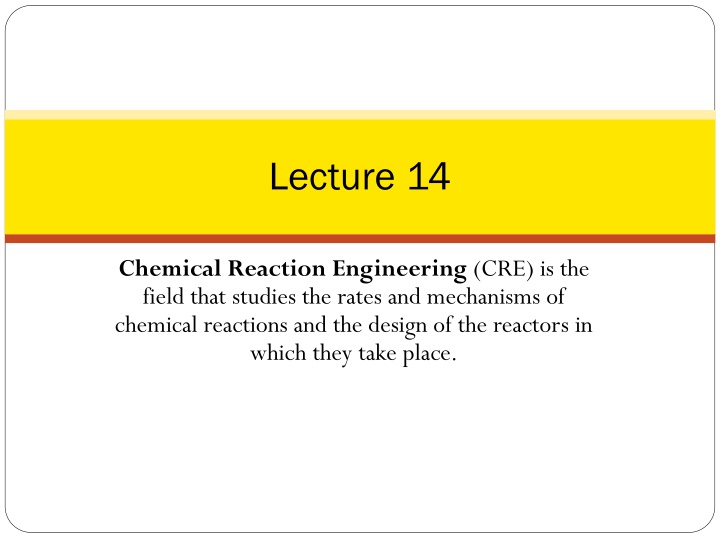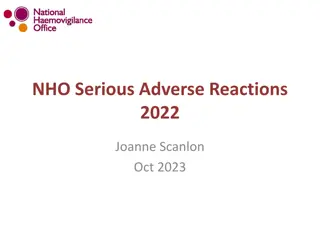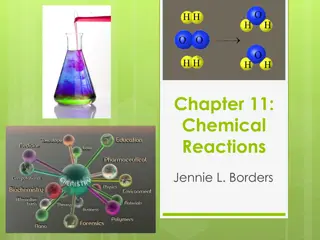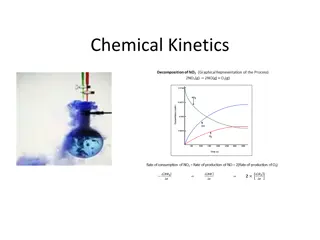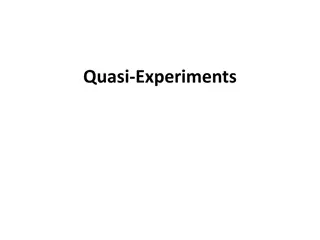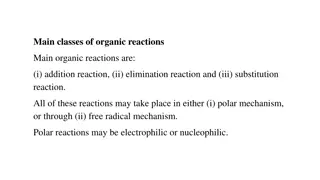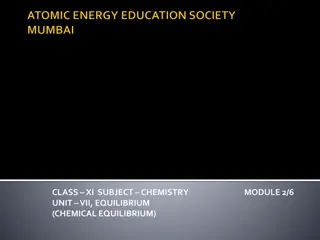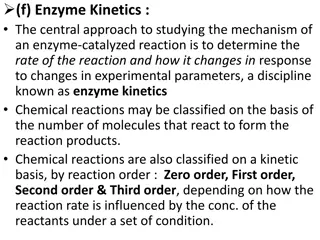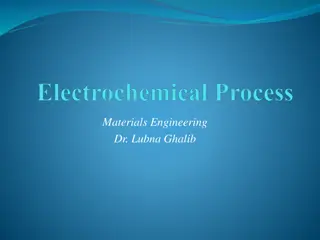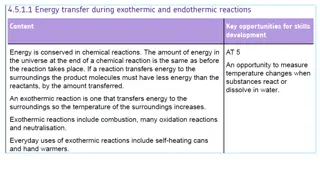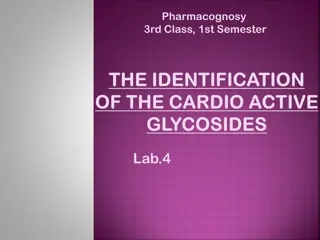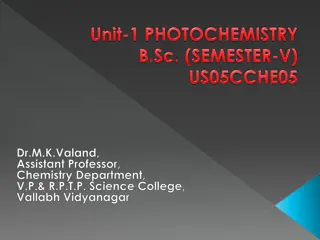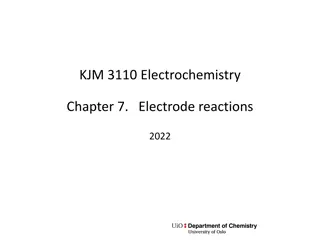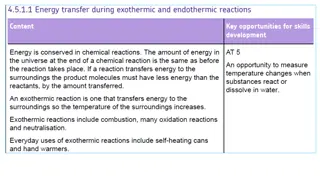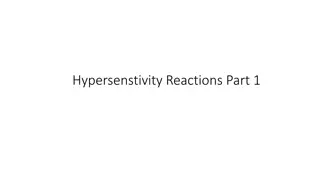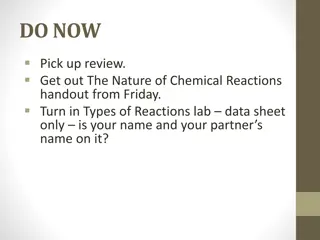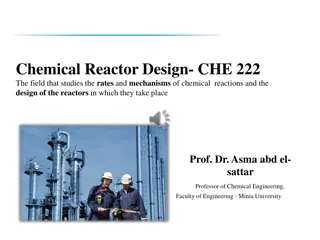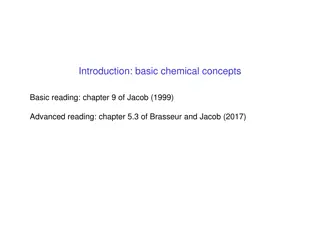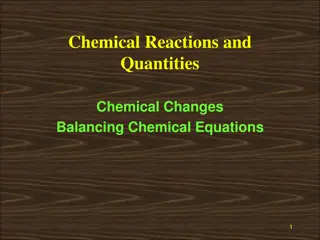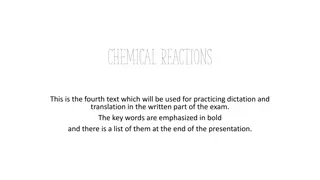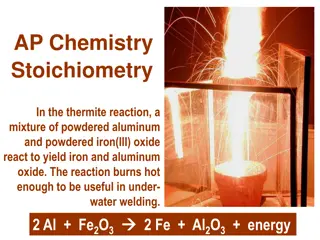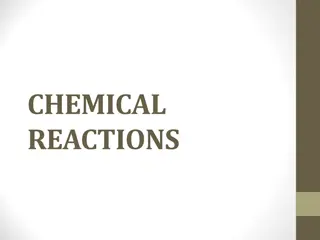Elementary Chemical Reactions Experiments
Engage elementary students in hands-on experiments to explore physical and chemical changes. Discover the differences between physical and chemical changes through engaging activities like observing color changes, gas release, and energy changes. Safety rules, group activities, and interactive experiments using test tubes and common household items encourage students to learn and apply scientific concepts in a fun and educational setting.
Download Presentation

Please find below an Image/Link to download the presentation.
The content on the website is provided AS IS for your information and personal use only. It may not be sold, licensed, or shared on other websites without obtaining consent from the author.If you encounter any issues during the download, it is possible that the publisher has removed the file from their server.
You are allowed to download the files provided on this website for personal or commercial use, subject to the condition that they are used lawfully. All files are the property of their respective owners.
The content on the website is provided AS IS for your information and personal use only. It may not be sold, licensed, or shared on other websites without obtaining consent from the author.
E N D
Presentation Transcript
Lecture 14 Chemical Reaction Engineering (CRE) is the field that studies the rates and mechanisms of chemical reactions and the design of the reactors in which they take place.
Lecture 14 Lecture 14 Thursday 2/28/2013 Thursday 2/28/2013 Pseudo Steady State Hypothesis (PSSH) Net rate of reaction of active intermediates is zero Hall of Fame Reaction: 2NO +O2 2NO2 Introduction to Enzyme Kinetics Begin non-Isothermal reactor design 2 2
Active Intermediates and PSSH An active intermediate is a molecule that is in a highly energetic and reactive state It is short lived as it disappears virtually as fast as it is formed. That is, the net rate of reaction of an active intermediate, A*, is zero. The assumption that the net rate of reaction is zero is called the Pseudo Steady State Hypothesis (PSSH) 3
Example The rate law for the reaction + A B C is found from experiment to be 2 kC + = A C r A 1 k A How did this rate law come about? Suggest a mechanism consistent with the rate law. 5
Example For reactions with active intermediates, the reaction coordinated now has trough in it and the active intermediate, A*, sits in this trough 6
Example - Solution ( ) 1 = + + k 2 A 1 * A r k C A A A * A 1 1 ( ) 2 + + k = A * A A A r k C C * 2 2 * 2 A A A ( ) 3 + k = A * B C r k C 3 3 * 3 * A A 7
Rate Laws: k3 is defined w.r.t. A* = 2 A r k C Reaction (1) (1) 1 * 1 A = r k C C Reaction (2) (2) 2 * 2 * A A A = Reaction (3) (3) r k C 3 * 3 * A A But C*Acannot be measured since it is so small = = * , A r r r r Relative Rates: 1 1 3 3 * A B A 8
Net Rates: Rate of Formation of Product (4) = = = r r r k C 3 3 * 3 * B B A A Pseudo Steady State Hypothesis r*A= 0 = (5) = + r r r r r * * 1 * 2 * 3 * A A A A A = = 2 A 0 k C k C C k C (6) 1 2 * 3 * A A A Solving for C * A 2 k C 1 + = A C * A k k C 3 2 A 9
in Equation (4) the rate of Substituting for formation of B is CA* 2 k k C (8) = 1 + 3 A r B k k C 3 2 A Relative rates overall + A B C r r = A B 1 1 2 k k C (9) = = 1 + 3 A r r A B k k C 3 2 A 10
For high concentrations of A, we can neglect in the denominator with respect to C k 3 k k2 C A A k 2 3 and the rate law becomes k k = = (10) 1 3 r C kC A A A k 2 (apparent first order) 11
For low concentrations of A, we can neglect in the denominator with respect to k3. k2 C A 3 k k C 2 A and the rate law becomes k k = = 2 A 2 A (11) 3 k 1 r C k C 1 A 3 (apparent second order) Dividing by k3and letting k =k2/k3and k=k1we have the rate law we were asked to derive 2 kC + = (12) A C r A 1 k A
Active Intermediates Why do so many reactions follow elementary rate laws? r = kC What about A A kC k C + = = ( ) r I Inert A A 1 ' I + + k ) 1 ( * A I A I 1 + + k ) 2 ( * A I A I 2 + k ) 3 ( A B C 3 k k + C 3 = 1 Ar - A C k k 2 2 I 13
Active Intermediates/Free Radicals and PSSH Hall of Fame Reaction The reaction: 2NO +O2 2NO2 has an elementary rate law = 2 NO NO r kC C O 2 2 However Look what happens to the rate as the temperature increases: -rNO2 14 T
Why does the rate law decrease with increasing temperature? Mechanism: + k * 3 NO O NO (1) 1 2 + k * 3 NO NO O (2) 2 2 + k (3) * 3 2 NO NO NO 3 2 Write rate of formation of product rNO2 Note: k3 is defined w.r.t. NO3* 15
Define k with respect to NO3* Assume that all reactions are elementary reactions, such that: [ ] [ ] O2 r1NO3=k1CNOCO2=k1NO 3= -k2CNO3 *= k2NO3 * r2NO* [ ] NO *= -k3CNO3 *CNO= k3NO3 * r3NO3 rNO2= 2 -r3NO3 * 16
The net reaction rate for NO3* is the sum of the individual reaction rates for NO3*: [ ] ] [ ] O2 * = r1 r1NO3 * = k1NO r1NO3 -r2NO3 [ *= r2 r2NO3 = * = -k2NO3 * = * 3 r r r k NO NO 3 3 * 3 *= r1NO3 * 3 3 3 NO NO *+r2NO3 *+r3NO3 rNO3 * = * 3 * 3 NO r k NO O k NO k NO NO 1 2 2 3 * 3 17
Pseudo Steady State Hypothesis (PSSH) Pseudo Steady State Hypothesis (PSSH) The PSSH assumes that the net rate of species A* (in this case NO3*) is zero. * 0 rNO3 [ ] O2 ]- NO3 ( = * 3 * 3 ) 0 k NO O k NO k NO NO 1 2 2 3 [ [ ] k2+ NO 0 = k1NO * [ ] ] [ ] O2 [ =k1NO k2+k3NO * NO3 18
Pseudo Steady State Hypothesis (PSSH) Pseudo Steady State Hypothesis (PSSH) ?1?? ?2 ?2+ ?3?? ] = [??3 = = * 3 2 2 r r NO NO NO * 3 3 NO 2 ???2= 2k1k3NO2O2 k2+ k3NO 19
Pseudo Steady State Hypothesis (PSSH) Pseudo Steady State Hypothesis (PSSH) k2>>k3NO [ ] ( ) + E E E k k A A O O 2 1 3 2 2 = = 1 k 3 1 A 3 2 2 r NO e NO RT 2 2 NO 2 2 2 ( ) + E E E 2 1 3 This result shows why the rate decreases as temperature increases. -rNO2 T 20
End Lecture 14 End Lecture 14 21 21
